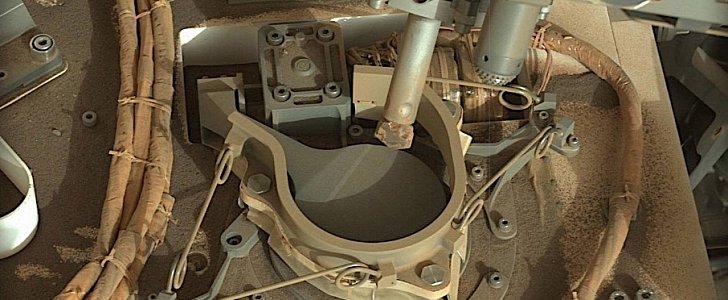Nearly two weeks ago, NASA announced the first Martian rock sample in more than a year has been picked up by the Curiosity rover following a series of remote repairs conducted from Earth.
The next step to making the rover fully operational again was the analysis of the said rock sample, in the form of Martian powder, inside the rover’s two laboratories. On Monday, NASA announced the procedure went as planned and the machine is now ready to continue its task.
The biggest challenge was making the new sample transfer technique work following the repairs. Via this new method, Curiosity positions its drill over two small inlets on top of the rover's deck, pouring in the appropriate amount of rock powder for the onboard laboratories to do the chemical and mineralogical analysis.
"This was no small feat. It represents months and months of work by our team to pull this off," said in a statement Jim Erickson, project manager of the Mars Science Laboratory mission.
"JPL's engineers had to improvise a new way for the rover to drill rocks on Mars after a mechanical problem took the drill offline in December 2016."
The problem with the rover’s drill was caused by a faulty motor. It prevented the drill head from extending and retracting between two stabilizers that pushed against the ground when the operation began, meaning the equipment could no longer reach the Martian soil.
NASA created a new way of drilling in the Martian soil called Feed Extended Drilling, or FED. FED lets Curiosity drill using the force of its robotic arm to push its drill forward and pull it back as it spins. As a result of the update, now the drill is at its fully extended position all the time.
Curiosity arrived on Mars in 2012. It is the size of a small SUV, measuring 9 feet 10 inches in length and 9 feet 1 inches in width (3 m by 2.8 m). The rover travels on 20-inch (50.8 cm) wheels which allow it to roll over obstacles up to 25 inches (65 centimeters) high.
The biggest challenge was making the new sample transfer technique work following the repairs. Via this new method, Curiosity positions its drill over two small inlets on top of the rover's deck, pouring in the appropriate amount of rock powder for the onboard laboratories to do the chemical and mineralogical analysis.
"This was no small feat. It represents months and months of work by our team to pull this off," said in a statement Jim Erickson, project manager of the Mars Science Laboratory mission.
"JPL's engineers had to improvise a new way for the rover to drill rocks on Mars after a mechanical problem took the drill offline in December 2016."
The problem with the rover’s drill was caused by a faulty motor. It prevented the drill head from extending and retracting between two stabilizers that pushed against the ground when the operation began, meaning the equipment could no longer reach the Martian soil.
NASA created a new way of drilling in the Martian soil called Feed Extended Drilling, or FED. FED lets Curiosity drill using the force of its robotic arm to push its drill forward and pull it back as it spins. As a result of the update, now the drill is at its fully extended position all the time.
Curiosity arrived on Mars in 2012. It is the size of a small SUV, measuring 9 feet 10 inches in length and 9 feet 1 inches in width (3 m by 2.8 m). The rover travels on 20-inch (50.8 cm) wheels which allow it to roll over obstacles up to 25 inches (65 centimeters) high.

